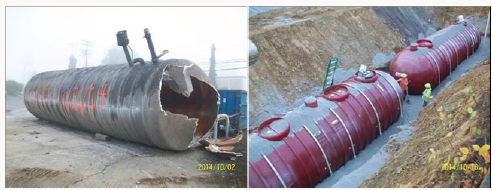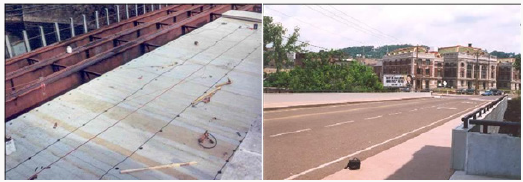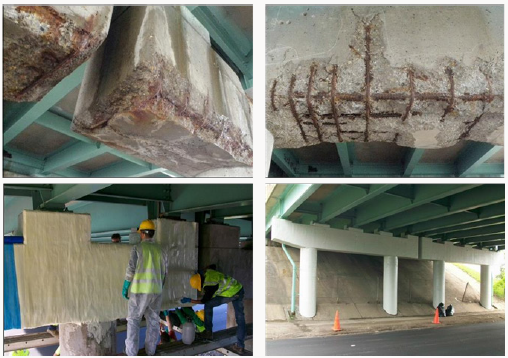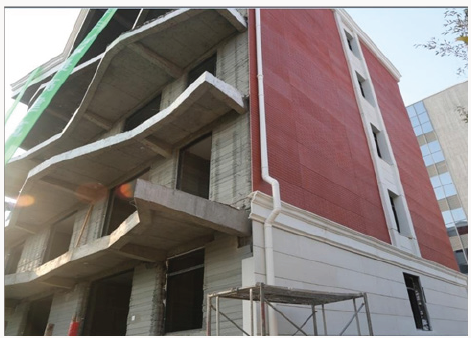
Lupine Publishers Group
Lupine Publishers
Menu
ISSN: 2637-4668
Short Communication(ISSN: 2637-4668) 
Advanced Material Development and Manufacturing, with Focus on Infrastructure Renovation Volume 2 - Issue 2
Hota Ganga Rao1* Maurice A2 and Jo Ann Wadsworth3
- 1Distinguished Professor of CEE, CEMR Director, Constructed Facilities Center, USA
- 2Statler College of Engineering and Mineral Resources, USA
- 3West Virginia University, USA
Received: May 04, 2018; Published:May 16, 2018
Corresponding author: Hota Ganga Rao, Distinguished Professor of CEE, CEMR, Director, NSF-IUCRC-CICI, Constructed Facilities Center, USA
DOI: 10.32474/TCEIA.2018.02.000135
Abbrevations: ASCE: American Society of Civil Engineers, FRP: Fibre Reinforced Polymer, NSF: National Science Foundation, CICI: Center for Integration of Composites into Infrastructure, IUCRC- Industry University Cooperative Research Center, AM: Additive Manufacturing, NIST: National Institute of Standards and Technology.
Introduction
Efficient infrastructure systems such as highways, bridges, buildings, pipelines, flood control systems, and utilities are all necessary for economy growth and a high standard of living. However, our infrastructure is in a dire state, as the American Society of Civil Engineers (ASCE) report card gives the US infrastructure a grade of D+. ASCE attributes the bulk of this low grade to the funding gap of about $2.00 trillion between revenue and infrastructure needs, which in turn costs each household $3,400 per year (ASCE, 2016). Advanced Fibre Reinforced Polymer (FRP) composite materials, comprised of two or more constituent materials, offer a more efficient use of taxpayer dollars compared to conventional materials. FRP composites can provide favourable material properties and enhanced service life, including noncorrosiveness and high strength to weight ratio. FRP composites have been used in infrastructure for over 30 years, including:
a) Reinforcing of degrading concrete bridge decks
b) Composite bridge decks
c) Pipelines and underground storage tanks
d) Power and transmission poles
e) Strengthening of in-service structures for blast, earthquake, and hurricane forces
f) Others
Over the past 30 years, various federal and state agencies have worked in cooperation with American composites industries to promote and advance the FRP composites for civil infrastructural applications. The shipment of advanced FRP composites in the US is about 5 billion lbs annually with about 32% of share in transportation and 21% in construction. Civil infrastructure relies on codes and standard practices built on the lessons learned over years of implementation. As such, the incorporation of new materials is outside the scope of the current codes, which increases the risk and complexity of the project. The US government has played a unique role in accelerating the adoption of advanced composite materials in advancing these materials for civil infrastructure projects (Figure 1).
Progression of Composites in Civil Infrastructure
Many developmental programs in FRP composites for civil infrastructure applications have been undertaken to allow for widespread field implementation. A number of field demonstration projects have been sponsored to better understand composites under real world field conditions. The vast majority of these field demonstration projects have been highly successful and are still in-service, several well beyond their original expected design life. Additionally, there have been many innovations with material development, efficient structural design, and manufacturing techniques. For example, the most successful story to tell is the evolution of FRP bridge decks, leading to six-fold increase in strength and a three-fold decrease in unit cost of FRP deck components over the past 20 years. Another research endeavour is the Development of FRP corrosion resistant composite pipes for natural gas transmission, thus enabling US energy to reach the market via US-produced FRP pipelines (Figure 2).
Technology Transfer
In addition to the major push in terms of fundamental research efforts since 1980s, US National Science Foundation (NSF) played a critical role in technology transfer strategies. For example, the Center for Integration of Composites into Infrastructure (CICI), a NSF Industry/University Cooperative Research Center (I/UCRC) program, provides an excellent platform for university and industry interaction. The 30 member CICI industrial advisory board directs collaborative research to benefit the entire FRP infrastructure industry. Currently CICI is collaborating with Mexican industries to advance the recycling of aerospace composites including student exchange and industry internship programs.
Design Codes
The advances through government sponsored programs resulted in developing numerous private and government codes and design guidelines, including FRP rebar, FRP strengthening of concrete members, and FRP design specifications for pultruded shapes. These codes and specifications would not exist today if not for previous government sponsored work. Advent of these codes will help FRP composites to compete on a level playing field with other construction materials like concrete, steel, wood and aluminium, materials with well-established codes. Performance criteria for design, specification and installation will mean a higher degree of confidence for professional engineers and contractors to design and construct with advanced composite materials, in addition to instilling confidence in owners to field implement advanced FRP composite materials (Figure 3).
Mass Production of Advanced Composite Materials
Manufacturing of composites is economical at mass scale via factory production using such methods as pultrusion, filament winding, resin transfer moulding and sheet moulding. Each of these methods has unique advantages, thus the manufacturing method is chosen to best fit the final application. For instance, filament winding is ideal for producing round structures such as flues for smokestacks, while pultrusion is best suited for very high strength structural shapes. Factory manufacturing is most cost-efficient with limited changes to the assembly line, thus costs can be greatly reduced when large quantities can be produced with a given setup. The past demonstration projects do not allow for these cost efficiencies to be realized. However, a commitment to specify a large quantities of advanced FRP composites would allow manufacturers to produce in bulk with less risk of excess inventory.
Additive Manufacturing (AM) for Rehabilitation of Constructed Facilities
A number of research groups have been able to use powerful AM tools to create high quality complex parts with advanced composite materials. AM has the potential to provide unique ability to research, design, develop, and produce a wide range of “engineered” parts in a matter of hours, including custom prosthetics, industrial grade aircraft and automotive parts, full size electric vehicles and a 6-story concrete apartment building,. Additive manufacturing is revolutionizing traditional fabrication and construction methods by producing high quality products with excellent durability characteristics.
In the US, many bridges are currently rated as structurally deficient and in need of repair. Based on recent patent pending work, WVU-CFC has demonstrated that structural integrity can be improved by focusing repairs at strategic locations in complex mechanical/structural systems; we intend to produce such parts in- situ to enhance structural integrity of large systems by several hundred percent. The WVU-CFC team further intends to use drones to 3D photograph structurally deficient bridges, and buildings, and then take advantage of AM printing techniques to retrofit these structures with 3D printed parts, to enhance their service life in the most economical manner (Figure 4).
Barriers for Broader Use of Advance Composites
Government sponsored R&D in composites has opened up new markets for composites in infrastructure. In just the highway system, advanced composites can be used for bridge decks, rebar, dowel bars, stringers, abutments, signposts, signboard, guardrail systems, sound barriers, and drainage systems. Each of these products represents a multibillion potential market and provide a longer service life than conventional materials, thus reducing future government expenses. Similarly, pipelines for gas, water and sewer are a billion dollar annual market, while the utility pole potential market is of an order of 4 billion dollars per year. To utilize the advantages of advanced composites, engineering communities need to reduce the ART TO PART gestation period. On February 8-9, 2017, NIST sponsored a workshop with a goal of determining the barriers to widespread adoption of polymer composites for sustainable infrastructure applications. There were 60 participants representing industry, government and academia that were informed by key stakeholders including owners, designers, and contractors on challenges they face in the infrastructure market. Breakout groups representing new construction, repair construction, and stand-alone FRP products used in the infrastructure market collaborated on the 5 most critical barriers to success in that respective sector. The most common barriers identified included training and education, codes and standards, composites durability and service life prediction, and testing. The US government can play a key role in breaking down these barriers by supporting efforts to evaluate in-service FRP composites, which would provide the data needed to evaluate durability and develop specifications.
Summary
With recent launching of new design codes, new markets will open up and existing markets will further broaden for the advanced composites industry. The support of the US government has been integral in the initial implementation of advanced composites. With continued support, manufacturers will continue to expand, creating jobs for Americans and improving our infrastructure. Advanced composite materials will become an integral part of civil infrastructure providing the American public benefits in terms of cost effectiveness and reduced user inconveniences due to easier installation, lower maintenance, longer service life, and greener products.
Note
This manuscript is a summary of the presentation made by Professor Hota Ganga Rao, PE to the US Congress (House of Representatives) Committee on ‘Energy and Commerce’ on March 15, 2017.

Top Editors
-

Mark E Smith
Bio chemistry
University of Texas Medical Branch, USA -

Lawrence A Presley
Department of Criminal Justice
Liberty University, USA -

Thomas W Miller
Department of Psychiatry
University of Kentucky, USA -

Gjumrakch Aliev
Department of Medicine
Gally International Biomedical Research & Consulting LLC, USA -

Christopher Bryant
Department of Urbanisation and Agricultural
Montreal university, USA -

Robert William Frare
Oral & Maxillofacial Pathology
New York University, USA -

Rudolph Modesto Navari
Gastroenterology and Hepatology
University of Alabama, UK -

Andrew Hague
Department of Medicine
Universities of Bradford, UK -

George Gregory Buttigieg
Maltese College of Obstetrics and Gynaecology, Europe -

Chen-Hsiung Yeh
Oncology
Circulogene Theranostics, England -
.png)
Emilio Bucio-Carrillo
Radiation Chemistry
National University of Mexico, USA -
.jpg)
Casey J Grenier
Analytical Chemistry
Wentworth Institute of Technology, USA -
Hany Atalah
Minimally Invasive Surgery
Mercer University school of Medicine, USA -

Abu-Hussein Muhamad
Pediatric Dentistry
University of Athens , Greece

The annual scholar awards from Lupine Publishers honor a selected number Read More...
















